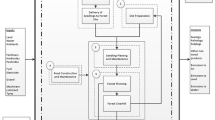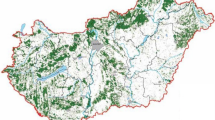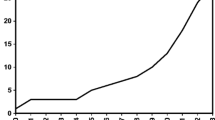Abstract
Background, aim and scope
Forest operations use large amounts of energy, which must be considered when life cycle assessment (LCA) methodology is applied to forest products. Forest management practices differ considerably between countries and may also differ within a country. This paper aims to identify and compare the environmental burdens from forest operations in Sweden and Spain focused on pulpwood production and supply to pulp mills.
Materials and methods
To perform the analysis, the main forest plantations were investigated as well as the most important tree species used in pulp mills in both countries: eucalyptus and, Norway spruce and Scots pine, were taken into account for the Spanish and Swedish case studies, respectively. Energy requirements for pulpwood production and supply to Spanish and Swedish pulp mills are evaluated in this paper. All forest operations from site preparation to extraction of felled wood to the delivery point at the roadside are included within the system boundaries as well as wood transport from forest landing to the pulp mill gate. Seedling and machinery production are excluded from the system boundaries due to lack of field data. The impact assessment phase was carried out according to the Swedish Environmental Management Council and, in particular, the impact categories assessed in forest and agricultural LCAs (global warming, acidification, eutrophication and photochemical oxidant formation) were analysed. SimaPro 7.10 software was used to perform the impact assessment stage.
Results
Different types of wood are produced in both case studies: softwood in Sweden and hardwood in Spain, with higher production of round wood and biomass per hectare in Sweden. Total energy use for pulpwood production and supply are in a similar order of magnitude, up to 395 MJ and 370 MJ/m3 solid under bark in Spain and Sweden, respectively. Field operations, such as silviculture and logging, are more energy-intensive in the Spanish case study. However, secondary hauling of pulpwood to pulp mill requires more energy in the Swedish case study. These important differences are related to different forest management practices as well as to pulpwood supply to the pulp mill. The eventual imports of pulpwood, application of pesticides, thinning step or final felling considerably affects energy requirements, which are reflected on the environmental results.
Discussion
Although differences between both case studies were observed, several stages were investigated: wood delivery to the pulp mill by road, harvesting and forwarding, contribute considerably to acidification, eutrophication and global warming potential in both cases. The type of wood, the machines used in forest operations (mechanised or motor-manual), the use of fossil fuels and the amount of wood produced influence the results. These differences must be kept in mind in comparative studies between such different countries.
Conclusions
The results obtained in this work allow one to forecast the importance of forest operations in LCA of forest products (in this case, wood pulp) and the influence of energy use in the results. Special attention has been paid in the inventory analysis stage for both case studies. It is possible to gain a better environmental performance in both case studies if alternative practices are considered, mainly focused on site preparation and stand tending in the Spanish system and on pulpwood supply in the Swedish one.
Recommendations and perspectives
This study provides useful information that can assist forest-based industries in the aim of increasing their sustainability. Future work will focus on the study of several transport alternatives of pulpwood supply including railway, road and ship. In addition, pulpwood processing in Spanish and Swedish paper pulp mills considered to be representative of the “state of art” will be carried out in order to get a complete picture of this kind of forest-based industry. In addition, the use of biofuels (such as forest biomass) instead of fossil fuels and CO2 uptake of wood via photosynthesis will be carried out in order to have a complete perspective of forest ecosystems.




Similar content being viewed by others
References
Ahlgren S (2003) Environmental impact of chemical and mechanical weed control in agriculture—a comparative study using life cycle assessment methodology. Doctoral Thesis. SLU, Uppsala, Sweden
Ahlvik P, Brandberg Å (2001) Well-to-wheel efficiency for alternative fuels from natural gas or biomass. Report 2001:85, Swedish National Road Administration, Borlänge, Sweden
Aldentun Y (2002) Life cycle inventory of forest seedling production—from seed to regeneration site. J Clean Prod 10:47–55
Amorós I, Alonso JL, Romaguera S, Carrasco JM (2007) Assessment of toxicity of a glyphosate-based formulation using bacterial systems in lake water. Chemosphere 67:2221–2228
Arrouays D, Balesdent J, Germon JC, Jayet PA, Soussana JF, Stengel P (eds) (2002) Contribution à la lutte contre l’effet de serre. Stocker du carbone dans les sols agricoles de France? Expertise Scientifique Collective. Rapport d’expertise réalisé par INRA à la demande du Ministère de l’Ecologie et du Développement Durable. Paris, France
Aspapel (2007) www.aspapel.es (cited October, 2007)
Athanassiadis D (2000) Energy consumption and exhaust emissions in mechanized timber harvesting operations in Sweden. Sci Total Environ 255:135–143
Athanassiadis D, Lidestav G, Wästerlund I (2000) Assessing material consumption due to spare part utilization by harvesters and forwarders. J Forest Eng 11:51–57
Audsley E (coord.), Alber S, Clift R, Cowell S, Crettaz P, Gaillard G, Hausheer J, Jolliet O, Kleijn R, Mortensen B, Pearce D, Roger E, Teulon H, Weidema B, Van Zeijts H (1997) Harmonisation of Environmental Life Cycle Assessment for Agriculture. Final Report. Concerted Action AIR3-CT94-2028. European Commission. DG VI Agriculture. SRI, Silsoe, United Kingdom
Baltic 21 FO 5-project (2007) Promotion strategies for enhanced use of wood and wood based products in the Baltic Sea Region and Strategic Export Markets. Final Report
Baumann H, Tillman AM (2004) The Hitch Hiker’s Guide to LCA. An Orientation in Life Cycle Assessment Methodology and Application. ISBN 9144023642, Studentlitteratur, Lund, Sweden
Berg S, Karjalainen T (2003) Comparison of greenhouse gas emissions from forest operations in Finland and Sweden. Forestry 76:271–284
Berg S, Lindholm EL (2005) Energy use and environmental impacts of forest operations in Sweden. J Clean Prod 13:33–42
BOE—Boletín Oficial del Estado (2006) No. 41:6342–6357 (in Spanish)
Brentrup F, Küsters J, Lammel J, Kuhlmann H (2000) Methods to estimate on-field nitrogen emissions from crop production as an input to LCA studies in the agricultural sector. Int J Life Cycle Assess 5:349–357
Brentrup F, Küsters J, Kuhlmann H, Lammel J (2004) Environmental impact assessment of agricultural production systems using the life cycle assessment (LCA) methodology I. Theoretical concept of a LCA method tailored to crop production. Eur J Agron 20:247–264
Charles R, Jolliet O, Gaillard G, Pellet D (2006) Environmental analysis of intensity level in wheat crop production using life cycle assessment. Agr Ecosyst Environ 113:216–225
Davis J, Haglund C (1999) Life Cycle Inventory (LCI) of Fertilizer Production. Fertilizer products used in Sweden and Western Europe. SIK-Report No. 654. Master’s Thesis, Chalmers University of Technology, Gothenburg, Sweden
Dias AC, Arroja L, Capela I (2007a) Life cycle assessment of printing and writing paper produced in Portugal. Int J Life Cycle Assess 12:521–528
Dias AC, Arroja L, Capela I (2007b) Carbon dioxide emissions from forest operations in Portuguese eucalypt and maritime pine stands. Scand J Forest Res 22:422–432
Djodjic F, Börling K, Bergström L (2004) Phosphorus leaching in relation to soil type and soil phosphorus content. J Environ Qual 33:678–684
EMEP/CORINAIR (2006) Atmospheric emission inventory guidebook. Technical report, No. 11. European Environment Agency, Copenhagen, Denmark
ENCE (2008) http://www.ence.es (cited December, 2008)
Eriksson E (2006) Thinning operations and their impact on biomass production in stands of Norway spruce and Scots pine. Biomass and Bioenerg 30:848–854
Eriksson E, Blingue M, Lövgren G (1996) Life cycle assessment of the road transport sector. Sci Total Environ 189(190):69–76
European Commission (2006) Forest-based industries. Pulp and paper manufacturing. Available on line at: http://ec.europa.eu/enterprise/forest_based/pulp_en.html (cited December, 2007)
European Commission (2007) Agriculture: Forestry measures. Main characteristics of the EU forest sector. Available on line at: http://ec.europa.eu/agriculture/fore/characteristics/index_en.htm (cited December, 2007)
Forsberg M (2002) Transmit—Driftstatistik och vägstandardens påverkan på bränsleförbrukningen. Arbetsrapport Nr 515. SkogForsk (The Forestry Research Institute of Sweden). Uppsala, Sweden. ISSN 1404-305X. (in Swedish)
Forsberg M, Löfroth C (2002) Transmit—Förarnas påverkan på bränsleförbrukning och utbildning i sparsam körning. Arbetsrapport Nr 516. SkogForsk (The Forestry Research Institute of Sweden). Uppsala, Sweden. ISSN 1404-305X. (in Swedish)
Frees N, Weidema BP (1998) Life cycle assessment of packaging systems for beer and soft drinks. Energy and transport scenarios. Technical report 7. Miljöprojekt nr. 406. Denmark: Ministry of Environment and Energy
Frischknecht R, Bollens U, Bosshart S, Ciot M, Ciseri L, Doka G, Dones R, Gantner U, Hischier R, Martin A (1996) Ökoinventare von Energiesystemen: Grundlagen für den ökologischen Vergleich von Energiesystemen und den Einbezug von Energiesystemen in Ökobilanzen für die Schweiz. 3. Gruppe Energie— Stoffe—Umwelt (ESU), Eidgenössische Technische Hochschule Zürich und Sektion Ganzheitliche Systemanalysen, Paul Scherrer Institut, Villigen, Bundesamt für Energie (Hrsg.), Bern, Switzerl
González-García S, Hospido A, Moreira MT, Romero J, Feijoo G (2009a) Environmental impact assessment of total chlorine free pulp from Eucalyptus globulus in Spain. J Clean Prod 17:1010–1016
González-García S, Feijoo G, Widsten P, Kandelbauer A, Zikulnig-Rusch E, Moreira MT (2009b) Environmental performance assessment of hardboard manufacture. Int J Life Cycle Assess (accepted)
González-García S, Berg S, Moreira MT, Feijoo G (2009b) Evaluation of forest operations in Spain under a life cycle assessment perspective. Scand J Forest Res. doi:10.1080/02827580902773462
González-García S, Berg S, Feijoo G, Moreira MT (2009c) Comparative environmental assessment of wood transport models. A case study of a SWEDISH pulp mill. Sci Total Environ 407:3530–3539
Gutierrez A, del Río JC, Martínez MJ, Martínez AT (2001) The biotechnological control of pitch in paper pulp manufacturing. Trends Biotechnol 19:341–348
Hauschild MZ (2000) Estimating pesticide emissions for LCA of agricultural products. In: Weidema BP, Meeusen MJG (eds), Agricultural Data for Life Cycle Assessments, vol. 2. LCANet Food, The Hague, The Netherlands, pp 64–79
Hansson PA, Burström A, Norén O, Bohm M (1998) Engine emissions from agricultural tractors and forestry machines. Report 232. Department of Agricultural Engineering, Swedish University of Agricultural Science, Sweden (in Swedish, abstract in English)
Holmgren K (2000) Katalysatorfunktion i tvåtaktsmotorer. SMP (The Swedish Machinery Testing Institute) (in Swedish)
IPCC, Intergovernmental Panel on Climate Change (2007) Climate Change 2007—the physical science basis. Contribution of Working Group I to the Fourth Assessment Report of the IPCC. Available online at: http://www.ipcc.ch/ipccreports/ar4-wg1.htm (cited January, 2009)
Johansson T, Basander C (2003) Aircraft emissions and sustainable development for aviation. Report. School of Aviation, Lund University, Sweden
Johansson K, Nilsson U, Lee Allen H (2007) Interactions between soil scarification and Norway spruce seedling types. New Forest 33:13–27
Jones RJA, Hiederer R, Rusco E, Loveland PJ, Montanarella L (2004) The map of Organic Carbon in Top soils in Europe: version 1.2—September 2003. Explanation of: Special Publication Ispra 2004 No. 72 (S.P.I.04.72). European Soil Bureau Research Report No. 17, EUR 21209 EN, p 26. Office for Official Publications of the European Communities, Luxembourg. Available on line at: http://eusoils.jrc.it/ESDB_Archive/eusoils_docs/other/OCtopMapBkLet76.pdf (cited November 2007)
Karjalainen T, Asikainen A (1996) Greenhouse gas emissions from the use of primary energy in forest operations and long-distance transportation of timber in Finland. Forestry 69:215–228
Karjalaimen T, Zimmer B, Berg S, Welling J, Schwaiger H, Finér L, Cortijo P (2001) Energy, carbon and other material flows in the life cycle assessment of forestry and forest products; achievements of the working group 1 of the COST action E9. European Forest Institute (EFI), Joensuu, Finland
Lehtonen A, Mäkipää R, Heikkinen J, Sievänen R, Liski J (2004) Biomass expansion factors (BEFs) for Scots pine, Norway spruce and birch according to stand age for boreal forests. Forest Ecol Manag 188:211–224
LFV Group—Swedish Airports and Air Navigation Services (2005) The LFV Group environmental data report (2005). Available on line at: http://www.lfv.se/templates/LFV_InfoSida_70_30____45984.aspx (cited November, 2007)
Lindholm EL (2006) Energy use in Swedish Forestry and its Environmental Impact. Licentiate Thesis. Department of Biometry and Engineering. SLU, Uppsala, Sweden
Lindholm EL, Berg S (2005a) Energy requirement and environmental impact in timber transport. Scand J Forest Res 20:184–191
Lindholm EL, Berg S (2005b) Energy use in Swedish Forestry in 1972 and 1997. Int J For Eng 16:27–37
Löfroth C, Jönsson P, Nordén B, Hofsten H (2007) Hybrid forwarder achieves considerable reduction in fuel consumption. Resultat från Skogforsk, Nr. 10. Uppsala, Sweden (in Swedish)
Markewitz D (2006) Fossil fuel carbon emissions from silviculture: impacts on net carbon sequestration in forests. Forest Ecol Manag 236:153–161
Mattsson S, Bergsten U (2003) Pinus contorta growth in northern Sweden as affected by soil scarification. New Forest 26:217–231
Michelsen O (2007) Assessment of land use impact on biodiversity: proposal of a new methodology exemplified with forestry operations in Norway. Int J Life Cycle Assess 13:22–31
Michelsen O, Solli C, Strømman AH (2008) Environmental impact and added value in forestry operations in Norway. J Ind Ecol 12:69–81
Milá i Canals L, Burnip GM, Cowell SJ (2006) Evaluation of the environmental impacts of apple production using life cycle assessment (LCA): case study in New Zealand. Agr Ecosyst Environ 114:226–238
Milà i Canals L, Bauer C, Depestele J, Dubreuil A, Freiermuth Knuchel R, Gaillard G, Michelsen O, Müller-Wenk R, Rydgren B (2007) Key elements in a framework for land use impact assessment within LCA. Int J Life Cycle Assess 12(1):5–15
Naturvårdsverket (2002) www.naturvardsverket.se (cited November, 2007)
Nebel B, Zimmer B, Wegener G (2006) Life cycle assessment of wood floor coverings. A representative study for the german flooring industry. Int J Life Cycle Assess 11:172–192
Nemecek T, Heil A, Huguenin O, Meier S, Erzinger S, Blaser S, Dux D, Zimmermann A (2004) Life cycle inventories of agricultural production systems. Ecoinvent report 2000. No.15. Agroscope FAL Reckenholz and FAT Taenikon, Swiss Centre for Life Cycle Inventories, Dübendorf, Switzerland
NTM—The Network for Transport and Environment (2007) Environmental Data for International Cargo Transport. Calculation methods—mode-specific issues. Road transport. Version 2007-04-13. Gothenburg, Sweden. Available on line at: http://www.ntm.a.se/english/eng-index.asp (cited November, 2007)
NTM—The Network for Transport and Environment (2007) Environmental Data for International Cargo Sea Transport. Calculation methods—mode-specific issues. Sea transport. Version 2007-09-07. Gothenburg, Sweden. Available online at: http://www.ntm.a.se/english/eng-index.asp (cited November, 2007)
Praktisk Skogshandbok (1994) Sveriges Skogsvårdförbund, Djursholm, Sweden (in Swedish)
PRé Consultants (2008) http://www.pre.nl (cited October, 2008)
Reciclapapel (2007) http://www.reciclapapel.org/htm/info/tecnica/ciclo/dconsumopastas.asp (cited October, 2007)
Rex ELC, Baumann H (2007) Individual adaptation of industry LCA practice: results from two case studies in the Swedish forest products industry. Int J Life Cycle Assess 12:266–271
Rivela B, Hospido A, Moreira MT, Feijoo G (2006a) Life cycle inventory of particleboard: a case study in the wood sector. Int J Life Cycle Assess 11:106–113
Rivela B, Moreira MT, Muñoz I, Rieradevall J, Feijoo G (2006b) Life cycle assessment of wood wastes: a case study of ephemeral architecture. Sci Total Environ 357:1–11
Rivela B, Moreira MT, Feijoo G (2007) Life cycle inventory of medium density fibreboard. Int J Life Cycle Assess 12:143–150
Rodríguez L, Macías F (2006) Eutrophication trends in forest soils in Galicia (NW Spain) caused by the atmospheric deposition of nitrogen compounds. Chemosphere 63:1598–1609
Schwaiger H, Zimmer B (2001) A comparison of fuel consumption and Greenhouse gas emissions from forest operations in Europe. In: Karjalainen T, Zimmer B, Berg S, Welling J, Schwaiger H, Finér L, Cortijo P (eds) Energy, carbon and other material flows in the Life Cycle Assessment of forestry and forest products—achievements of the working group 1 of the COST action E9 (Discussion paper 10, pp 33–53). European Forest Institute, Joensuu, Finland
Schweinle J (2007) Wood and other renewable resources: A challenge for LCA. Int J Life Cycle Assess 12:141–142
SEMC—Swedish Environmental Management Council (2000) Requirements for Environmental Product Declarations (EPD). An application of ISO TR 14025 TYP III Environmental Declarations. MSR 1999: 2
Sigoillot C, Camarero S, Vidal T, Record E, Asther M, Pérez-Boada M, Martínez MJ, Sigoillot JC, Asther M, Colom JF, Martínez AT (2005) Comparison of different fungal enzymes for bleaching high-quality paper pulps. J Biotechnol 115:333–343
Skogsstatistisk Årsbok (2007) Official Statistics of Sweden. Swedish Forest Agency, Jönköping, Sweden
Swedish Forest Agency (2008) http://www.skogsstyrelsen.se/episerver4/default.aspx?id=38515 (cited February, 2009)
Uppenberg S, Almemark M, Brandel M, Lindfors LG, Marcus HO, Stripple H, Wachtmeister A, Zetterberg L (2001) Bakgrundsinformation och Teknisk bilaga. Miljöfaktabok för bränslen, Del 2.—IVL Svenska miljöinstitutet AB, IVL Rapport B1334-2A, Stockholm, Sweden, p 172
Välimaa C, Stadig M (1998) Växtnäring i livscykelanalys. SIK Report no 637. The Swedish Institute for Food and Biotechnology. Gothenburg, Sweden
Werner F, Nebel B (2007) Wood & other renewable resources. Int J Life Cycle Assess 12:462–463
Werner F, Richter K (2007) Wooden building products in comparative LCA. A literature review. Int J Life Cycle Assess 12:470–479
White MK, Gower ST, Ahl DE (2005) Life cycle inventories of roundwood production in northern Wisconsin: inputs into an industrial forest carbon budget. Forest Ecol Manag 219:13–28
Acknowledgements
This study was developed within the framework of the BIORENEW Integrated Project (project reference: NMP2-CT-2006-026456). S. González-García would like to express her gratitude to the Spanish Ministry of Education for financial support (Grant reference AP2005-2374). The authors would also like to thank ENCE and Domsjö pulp mills for the inventory data (published and unpublished) provided as well as to Skogforsk staff for all the information supplied. The paper has also gained from the cooperation with workings in project number 518128 EFORWOOD within Thematic priority 6.3 Global Change and Ecosystems.
Author information
Authors and Affiliations
Corresponding author
Additional information
Responsible editor: Jörg Schweinle
Rights and permissions
About this article
Cite this article
González-García, S., Berg, S., Feijoo, G. et al. Environmental impacts of forest production and supply of pulpwood: Spanish and Swedish case studies. Int J Life Cycle Assess 14, 340–353 (2009). https://doi.org/10.1007/s11367-009-0089-1
Received:
Accepted:
Published:
Issue Date:
DOI: https://doi.org/10.1007/s11367-009-0089-1




